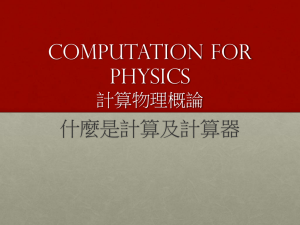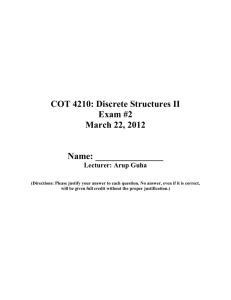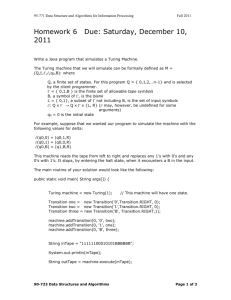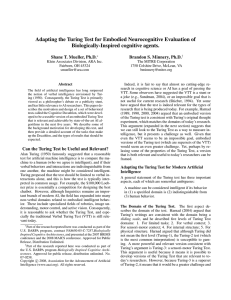Ned Block: “The Computer Model of Mind”
advertisement
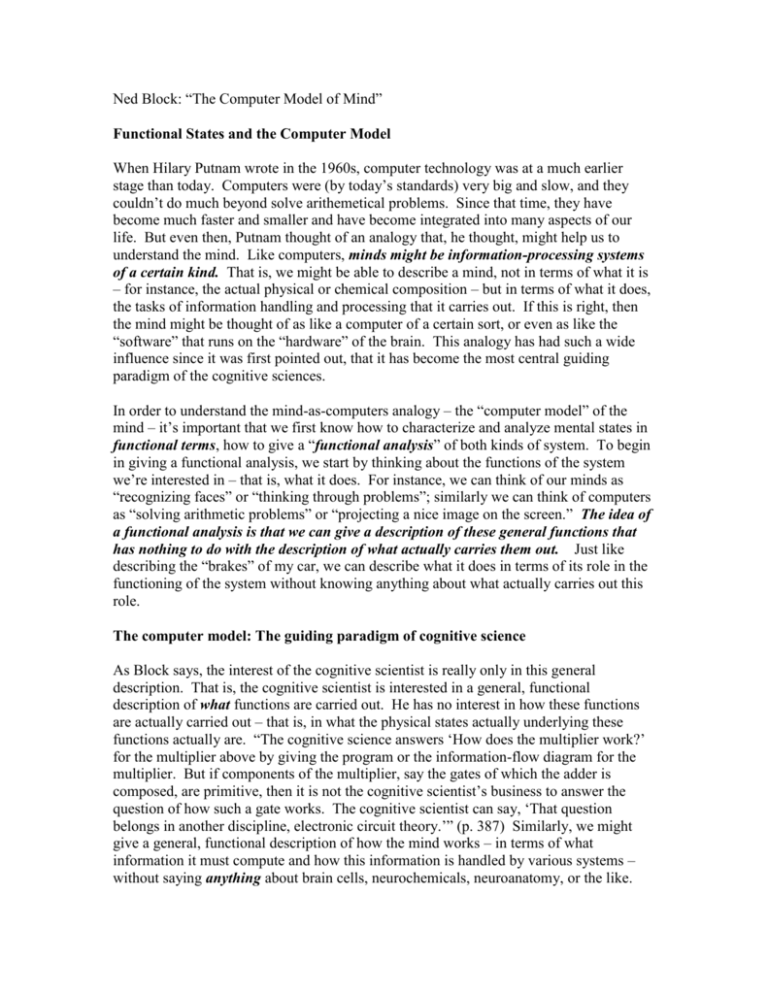
Ned Block: “The Computer Model of Mind” Functional States and the Computer Model When Hilary Putnam wrote in the 1960s, computer technology was at a much earlier stage than today. Computers were (by today’s standards) very big and slow, and they couldn’t do much beyond solve arithemetical problems. Since that time, they have become much faster and smaller and have become integrated into many aspects of our life. But even then, Putnam thought of an analogy that, he thought, might help us to understand the mind. Like computers, minds might be information-processing systems of a certain kind. That is, we might be able to describe a mind, not in terms of what it is – for instance, the actual physical or chemical composition – but in terms of what it does, the tasks of information handling and processing that it carries out. If this is right, then the mind might be thought of as like a computer of a certain sort, or even as like the “software” that runs on the “hardware” of the brain. This analogy has had such a wide influence since it was first pointed out, that it has become the most central guiding paradigm of the cognitive sciences. In order to understand the mind-as-computers analogy – the “computer model” of the mind – it’s important that we first know how to characterize and analyze mental states in functional terms, how to give a “functional analysis” of both kinds of system. To begin in giving a functional analysis, we start by thinking about the functions of the system we’re interested in – that is, what it does. For instance, we can think of our minds as “recognizing faces” or “thinking through problems”; similarly we can think of computers as “solving arithmetic problems” or “projecting a nice image on the screen.” The idea of a functional analysis is that we can give a description of these general functions that has nothing to do with the description of what actually carries them out. Just like describing the “brakes” of my car, we can describe what it does in terms of its role in the functioning of the system without knowing anything about what actually carries out this role. The computer model: The guiding paradigm of cognitive science As Block says, the interest of the cognitive scientist is really only in this general description. That is, the cognitive scientist is interested in a general, functional description of what functions are carried out. He has no interest in how these functions are actually carried out – that is, in what the physical states actually underlying these functions actually are. “The cognitive science answers ‘How does the multiplier work?’ for the multiplier above by giving the program or the information-flow diagram for the multiplier. But if components of the multiplier, say the gates of which the adder is composed, are primitive, then it is not the cognitive scientist’s business to answer the question of how such a gate works. The cognitive scientist can say, ‘That question belongs in another discipline, electronic circuit theory.’” (p. 387) Similarly, we might give a general, functional description of how the mind works – in terms of what information it must compute and how this information is handled by various systems – without saying anything about brain cells, neurochemicals, neuroanatomy, or the like. The idea is for the cognitive scientist to give this general description of the “function” or “program” that the brain is carrying out – and then leave the details of how it actually does carry it out to the neuroscientists. The computer model: Turing Machines To understand in more detail how we might give a functional analysis of the mind, we need to understand how we might give a functional analysis of a computer. In fact, all computers are based on a single functional idea and all of them are describable as a certain kind of functional system. In the late 1940s – even before there were any physical computers – Alan Turing came up with the general functional description that works for any computer whatsoever. This general description is called a “Turing machine.” The idea is that every computer of whatever type needs a few basic parts. One part is the data store or memory – where information is stored and held to be worked on. Another part is the “processor” – what actually carries out the information manipulation. Another part is the instructions that the processor must follow, or the program that it will carry out in working on the data. If we have all three parts, working together, we have a computer. Turing’s idea was to model these three parts in terms of an idealized system as follows. We start with an infinitely long “tape” on which information is recorded, perhaps in the form of 0’s and 1’s, on distinct squares. (This tape could be made of paper, or actual magnetic tape, or a long piece of rope, or whatever – all that matters is that we can make two different kinds of marks on it). At the beginning, the information on this tape represents the “input” information that we start with. There is also a “processor” or a “head” that can read information and also change the information on the tape – for instance, if the instructions say to, it can take a 0 and change it to a 1, or vice versa. At any time, this processor can be in any of a number of different “states.” (we can call these state 1, state 2, state 3, etc.). Finally, there are instructions determining what the processor will do. For instance, one of the instructions might say: “if you are in state 5, and you see a 0, go into state 6 and move one square to the right.” Or it might say, “If you are in state 3, and you see a 1, change it to a 0, go into state 7 and go one square to the left.” Collectively, the instructions make up a sort of “program” for the machine – they determine exactly what it will do with the information “inputted” on the tape to transform it to the information we want. It turns out that we can model the behavior of any computer whatsoever as being a Turing machine. Instead of a long tape for memory, we might use a hard disk or CD-R. And instead of a moving “head,” the processor is the computer’s main processing chip. But these details are irrelevant to the functional description – in fact, all computers are Turing machines. By giving the machine different programs – different instruction sets for what the processor should do – we can get it to solve any problem we like. Multiple Realizability Again Notice that, because a description in terms of Turing machines is a functional description, we can describe computers as having this functional description without saying anything about what they’re made up. We can make a Turing machine out of paper and metal, or we can make it out of rope and levers, or we can make it out of beer cans and string. It doesn’t matter at all what we make it out of – just that the parts, whatever parts we use, are interrelated in the right (functional) way. That is, Turing machines are multiply realizable, just like mental states, according to Putnam. There is some general description of every “information-processing” program that says nothing at all about the underlying physical nature of the brain or computer states realizing them – we can leave these details, again, for neurology or for electrical engineering. This gives cognitive scientists – if the analogy works, at least – access to a very general way of characterizing the mind in physical terms. For if functionalism is true, then we can describe mental states as things that sometimes happen in brains, but could also happen in computers or in Martians just as well. This makes it possible for researchers in a wide variety of fields – engineering, artificial intelligence, and psychology are just some – to be working on the same general problems of information processing, even though they are working with very different “media” or realizations. It is this possibility that has provided much of the impetus behind what has come to be called “cognitive science” over the last several decades.




